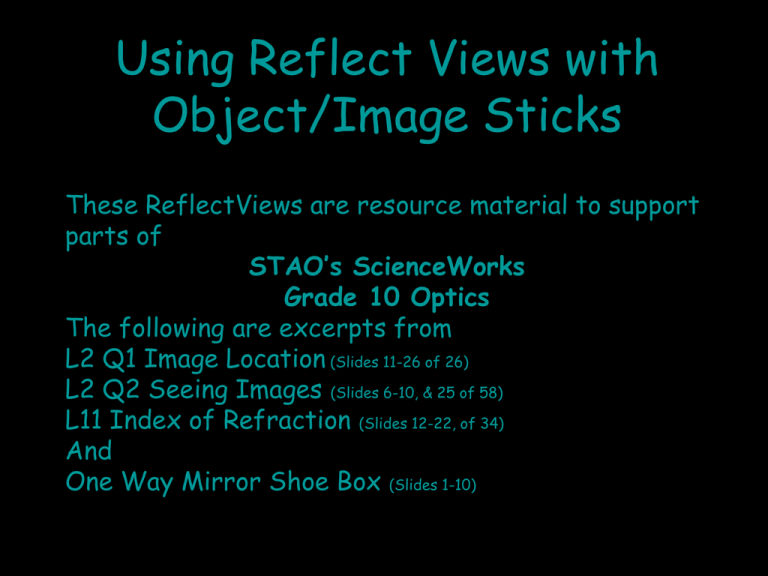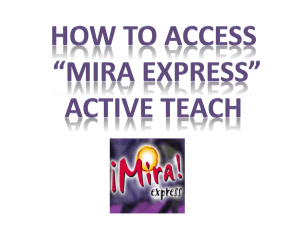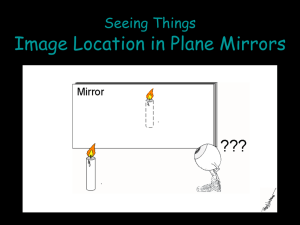Using Reflect Views with Object/Image Sticks
advertisement

Using Reflect Views with Object/Image Sticks These ReflectViews are resource material to support parts of STAO’s ScienceWorks Grade 10 Optics The following are excerpts from L2 Q1 Image Location (Slides 11-26 of 26) L2 Q2 Seeing Images (Slides 6-10, & 25 of 58) L11 Index of Refraction (Slides 12-22, of 34) And One Way Mirror Shoe Box (Slides 1-10) Question 1) Where does the Image appear to be located in a Plane Mirror? Image Location Lab Image Location Lab 1) Place an Object in front of the MIRA on a sheet of scrap paper. 2) Notice you can see a reflection of the Object in the MIRA. If you use an Object/Image Stick you even see the word Image in the reflection. 3) Place an Image locator (a second Object/Image Stick) behind the MIRA. 4) You can see the Image locator through the MIRA. If you use an Object/Image Stick, turn it around so that you can see the word Image through the MIRA 5) Move the Image locator until it appears to overlap the Image. 6) Trace the location of the Object. 7) Trace the location of the Mirror. 8) Trace the location of the Image (Image locator). 9) Move the Object twice (2X’s) more 10) Trace all Object and the Image locations 11) Be careful to keep the MIRA in the same place. 12) You should have a piece of paper that looks similar to O1 O2 I2 O3 13) Draw a line from the centre of the Object to the centre of the Image so you have have a piece of paper that looks similar to O1 I3 O2 O3 14) What are two observations that can be used to predict the position of the Image in a mirror? 15) Try the Bulls Eye activity I1 I2 I1 I3 Your Turn Do the Image Location Lab Image Location Lab Answers Follow 1) What are two observations that can be used to predict the position of the Image in a mirror? a) The distance from the Object to the Mirror is the same as the distance from the Image to the Mirror. b) The line connecting the Object and Image intersects the Mirror at 90 ° 2) Use your observations to show where, and then describe how, you would place a MIRA or Reflect-View so that the tip of the arrow always appears to hit the Bulls Eye a) Draw a line connecting the Arrow Tip and the Bulls Eye (Object & Image) 2) Use your observations to show where, and then describe how, you would place a MIRA or Reflect-View so that the tip of the arrow always appears to hit the Bulls Eye b) Place the Mirror in the middle of the line 2) Use your observations to show where, and then describe how, you would place a MIRA or Reflect-View so that the tip of the arrow always appears to hit the Bulls Eye b) Place the Mirror in the middle of the line and rotate it 90° to the line. 2) Use your observations to show where, and then describe how, you would place a MIRA or Reflect-View so that the tip of the arrow always appears to hit the Bulls Eye Question 2) From Viewing Images in Plane Mirrors L2Q2SeeingImage How can the light rays appear to go through an opaque Mirror? In your notes you see this graphic . Place a MIRA or Reflect View on it as shown . Place a MIRA or Reflect View on it as shown . Place a MIRA or Reflect View on it as shown . Notice you can see an Image in the “Mirror” If you look over the top, behind the Mirror there is no Image. The light rays must come from the Object and reflect off the Mirror . How do they do this? Reality Check Use a MIRA or Reflect View to see if the Predicted Image you drew and the real Image, overlap. If they do the light rays must reflect as predicted See-Through-Loo From L11 Index of Refraction Inside View Outside View This is a picture of a public toilet in Switzerland that's made entirely out of one-way glass. No one can see you in there, but when you are inside, it looks like you're sitting in a clear glass box. http://www.snopes.com/photos/arts/toilet.asp 7) What does this have to do with Refraction? See-Through-Loo Inside View Whenever light passes from one medium to another it partially refracts and partially reflects. Outside View 7) What does this have to do with Refraction? See-Through-Loo Inside View Whenever light passes from one medium to another it partially refracts and partially reflects. Outside View 7) What does this have to do with Refraction? See-Through-Loo Did you notice the reflected ray in the activity? Inside View Whenever light passes from one medium to another it partially refracts and partially reflects. Outside View Partial reflection / refraction also occurs in windows. Part of the light striking the window refract through and part reflects back into the room If there is a difference between light brightness on either side of a window, the light from the bright side will refract strongly through and reflect more strongly back into the room. The person in the room will see a strong reflection of themselves compared to the image refracted from the other side If there is a difference between light brightness on either side of a window, the light from the bright side will refract strongly through and reflect more strongly back into the room. The person in the room will see a strong reflection of themselves compared to the image refracted from the other side If one side of a window is dark, the light from the bright side will refract strongly through and reflect strongly back into the room. The person in the room will only see a reflection of themselves and nothing refracted from the other side. In this case, the Girl sees the Boy. The Boy sees his reflection If one side of a window is dark, the light from the bright side will refract strongly through and reflect strongly back into the room. The person in the room will only see a reflection of themselves and nothing refracted from the other side. In this case, the Boy sees the Girl. The Girl sees her reflection If glass is partially coated with a metal like aluminum or silver, the partial reflection is strengthened so that the difference in light intensity is not as important. This is the principle of a one way mirror Check out the One Way Mirror Shoe Box See-Through-Loo Inside View Outside View Inside the “Loo” is dark so that there is little light to refract out. Note the weak reflection from inside. Outside the “Loo” is bright so there is lots of light to reflect back and refract inside. One Way Mirror Shoe Box Materials You need; Utility knife Shoe box (black or dark colours work best) Cardboard Reflect-View (best) but MIRA will work 1) Cut an “I” slit in the middle of both sides of a shoe box. 2) Then cut a viewing hole in both ends 3) Put a Reflect-View in the “I” slit. The top and bottom of the “I” allows the Reflect-View to slide in more easily. 3) Put a Reflect-View in the “I” slit. The top and bottom of the “I” allows the Reflect-View to slide in more easily. 4) Cut a two holes in the lid as shown. These are to let light into one chamber of the box, or the other, or both. 5) Place the lid on the top and view a partner while sliding a cover over one light transmitting hole then the other. 5) Place the lid on the top and view a partner while sliding a cover over one light transmitting hole then the other. 6) A dark, opaque cloth over both you and your partners head improves the effect. It is important that there is very little light on the “dark side” 6) A dark, opaque cloth over both you and your partners head improves the effect. It is important that there is very little light on the “dark side”






